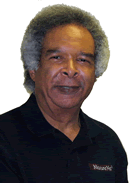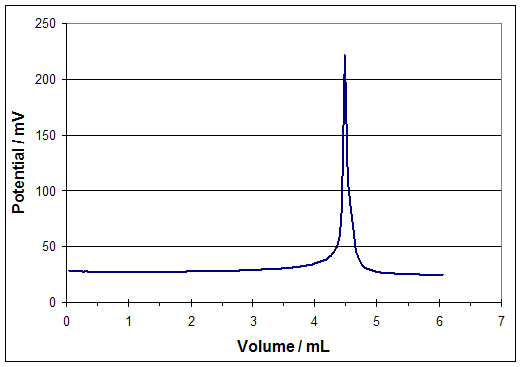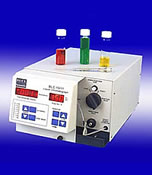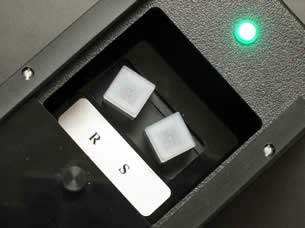
January 8, 2006
MeasureNet’s Web Data Storage System
Did you know that the MeasureNet® data acquisition system allows you to store data on the web? Yes! MeasureNet® makes it possible for your students to upload their experimental data files onto a commercial web server controlled by MeasureNet®. The advantage of this process is that your students can then access (download) their laboratory data at any location in the world where there is a computer connected to the internet. This is a powerful tool that is available for use by you and your students through MeasureNet®.
How does it work? To upload files to the server several requirements must be met. First, obtain space on the server from us, and then designate a department administrator (or class instructor) from your institution to set up the laboratory course on the website. This person will add the students’ names to the course and then add the experiment(s) to be performed. Second, the course and the student list must be downloaded to the laboratory computer connected to the Measurenet® network. Third, the instructor must have enabled “uploading files” on that laboratory computer during the current laboratory session. Finally, the students must be logged on when they actually upload their data sets. Don’t worry, the entire procedure is not as complicated as it sounds. It is described in detail along with pictured examples in the new MeasureNet® User Guide. You can also always contact me or my colleagues for further help.
A general overview: The MeasureNet® web storage system is a complex database application that resides on a commercial network server. It provides for individual password accounts for all of the students in a given laboratory course. The students upload their MeasureNet® data files collected from an experiment through the system's single network computer to the web storage site. The only requirements are that an account for the institution must exist on the web storage site and the computer on each MeasureNet® network must be connected to the internet. If you have multiple networks in your laboratory, the single computer belonging to each network must be internet-connected!
While you do not have to purchase any additional hardware to take advantage of this feature, you do need to have a MeasureNet® administrator create an account on the storage site. Once everything is done, all data will be stored in this account (in addition to being copied to the local hard drive of each network's computer) and will be accessible only to you and your students. Many of our institutions find such post-acquisition data availability a valuable feature that permits greater flexibility in the use of lab time.
To find out more about the web data storage system contact us at MeasureNet® or email me at brooks@MeasureNet-tech.com.
Happy New Year!

Elwood Brooks, Ph.D. is a MeasureNet Senior Applications Specialist still smarting from the Cincinnati Bengals' exclusion from the NFL playoffs. He can be reached at brooks@measurenet-tech.com

MeasureNet Spectrum Quarterly; November, 2005
I thought that I’d deviate from our normal discussion of probe care to answer some of the questions about our newest device, the colorimeter.
“What is a colorimeter and how is it different from a spectrometer?”
Colorimeters are generally simple photoelectric devices used to measure light over selected, relatively wide, frequency ranges in the visible region of the electromagnetic spectrum. A spectrometer is a more complex device designed to first disperse the light into the wavelengths present and then measure narrow regions anywhere along the electromagnetic spectrum. Our colorimeter, for example, produces three separate colored bands of light-red, green, and blue-using a three-color light emitting diode (LED). Our standard spectrometer, on the other hand, covers all frequencies in the visible and near infrared spectrum. It employs a monochromator and a diode array detector to provide one nanometer resolution over the entire range.
“Why would I need a colorimeter in my lab if I have a MeasureNet spectrometer?”
This is a very good question. Let me answer it this way. Let’s say you want to do a simple kinetics experiment in your laboratory. Since the spectrometer is designed to be a shared device, it would be inconvenient to use by multiple groups of students for the large number of repeated measurements required to follow the course of the reaction. The colorimeter, on the other hand, is a much simpler, less expensive device, and each student group (i.e., each workstation) has its own. They are not shared. The colorimeter determines the absorbance of the reaction mixture twice per second, allowing your students to easily follow reactions occurring over times ranging from one or two minutes up to many minutes.
Another reason for getting colorimeters for your students is that the unit also functions as both a fluorimeter and a turbidimeter. Yes! We’ve combined these two features along with the colorimeter into one single unit. This means a new group of optical experiments can easily be incorporated into your laboratory at no extra cost.
“Is the colorimeter difficult to install and use?”
Those of you who have known us for a while know that we at MeasureNet attempt to make the instrumentation as simple as possible to use. We don’t want your students spending valuable laboratory time trying to figure out how to use instrumentation. We want them spending their time learning chemistry! Adding our colorimeter to your existing MeasureNet equipment only requires you to install new software in your controller and on your PC. If you need help with this, you can always contact us and we’ll guide you through this process. For our new customers who buy computers from us, your networks will be set up for you at the factory.
You use the colorimeter like any other MeasureNet probe. Simply plug it into the station and follow the usual simple menus to choose the LED color, calibrate (set 0% and 100% T), and begin measuring. The spectrometer can come in handy here for determining which of the LED colors is most strongly absorbed by the substance to be studied, and will therefore be the easiest to measure.
“Is your colorimeter different from other brands?”
Yes! We all use LEDs, but one of the problems with using LEDs for light sources is that they drift with time as they warm up. That makes it difficult to get accurate results for kinetic experiments in some systems. Some vendors pulse the LED to keep it cooler to help decrease the drift. We made a fundamentally different choice. The MeasureNet colorimeter incorporates a double beam design, and our testing shows that this configuration almost completely eliminates the problem of drift. Absorbance readings on simple samples are very stable over long time periods.
“I really like the MeasureNet concept but I have some other probe brands. Will these other probes, like a colorimeter, interface with MeasureNet?”
No! MeasureNet probes are designed specifically to work on our system. That allows us to provide the best data collection system possible for the cost. Probes designed for other systems are not compatible with MeasureNet and cannot be used. This does not include, however, various standard devices such as pH electrodes and ion-selective electrodes, which are available from numerous suppliers in addition to MeasureNet.
Keep your questions coming!

Elwood Brooks, Ph.D. is a MeasureNet Senior Applications Specialist, motorcycle enthusiast, and Cincinnati Bengals fan. He can be reached at brooks@measurenet-tech.com

MeasureNet Spectrum Quarterly; July, 2005
Probes, we wish they were not so delicate...
Unfortunately for us, most phenomena that take place in the chemistry laboratory are beyond the ability of our natural senses to detect. We can tell if a solution is hot or cold, blue or red, or acidic or basic using our natural senses; but if we want to quantify these observations, we need to use some type of probe to measure the response.
A probe may be a device such as a thermometer costing a few dollars, or an expensive spectrometer costing hundreds of thousands of dollars. Regardless of cost, our man-made probes are delicate devices that were developed for one reason: to obtain information about a chemical or physical system. Therefore, it becomes very important for us to give our probes the proper care so they will correctly give us the needed information.
I decided to start our discussion on probe care with the pH electrode, as it is commonly called. The probe that MeasureNet Technology provides is a refillable Ag/AgCl type combination electrode. By combination electrode we mean that a single unit contains both the glass electrode and the reference electrode. In the laboratory, this probe is quite robust and ideal for the general H+ concentration measurements. The probe needs a limited amount of care, and will give you several years of service if taken care of properly.
When a new probe arrives at your laboratory, slide the rubber sealing ring down and fill the inside chamber with the saturated AgCl/KCl solution. Rinse the electrode tip with distilled water, blot it gently with a Kimwipe, and the probe is ready to be used.
You should never immerse the probe into solutions containing heavy metals, proteins, sulfides, tris-buffers, organic solutions, oils, or greases. These materials coat the glass bulb or poison the active sites on the bulb surface leading to probe failure. In some cases the probe may be restored, but before attempting to do so, contact us. Never rub the electrode surface, as this will destroy the hydrated gel layer. Be careful to blot the glass bulb gently if the need arises.
Do not store a pH probe in tap or distilled water. This will leach the ions from the hydrated gel layer of the glass and lead to electrode failure. Electrode storage solution may be purchased from chemical supply stores or prepared by dissolving 10g of KCl into 100ml of pH 4 phthalate buffer solution. Be sure to change your storage solution annually, as those little bugs will grow in almost anything.
With these few tips your pH probe will give you several years of reliable service.
Happy titrations,

Elwood Brooks, Ph.D. is a MeasureNet Senior Applications Specialist and motorcycle enthusiast. He can be reached at brooks@measurenet-tech.com
April 8, 2008
MeasureNet Technology Ltd. has announced a major software upgrade for the instructor PC attached to each data acquisition network. The new software will integrate support for multiple network controllers by a single PC, eliminating the current need to assign one PC for each 12-station network. Instructors will continue to have live access to any local student data acquisition in this multiple network arrangement.
The software will also present a number of functional changes. Instructors will have increased flexibility for viewing and assessing student data such as adjusting data parameters and identifying points on a curve in the data view mode. Collaborative activities between institutions will be supported by the ability, with the appropriate permissions, to remotely monitor live data acquisitions from other institutions. Also, the new software will enable remote diagnostics to enhance timely hardware and software troubleshooting.
The upgrade has been structured so that the new “look” of the user interface, as well as many of the data views, can be easily changed via custom plug-ins written by end users. MeasureNet plans improvements to its network software in the 2008-2009 period.
MeasureNet is the only data acquisition system for the science teaching laboratory with out-of-the-box LIMS (Laboratory Information Management System) features that include remote data retrieval, in-lab instructor monitoring of student acquisitions, and distance monitoring of data acquisitions by collaborating institutions.
MeasureNet Technology Ltd. manufactures patented, network-based data acquisition interfaces for science teaching laboratories. It is a spin-off of the University of Cincinnati's Department of Chemistry and is headquartered in Cincinnati, Ohio. Measurenet's award-winning, PC-reducing design helps reduce laboratory maintenance and operational costs while giving students access to high quality shared UV-vis spectroscopy, gas chromatograph and HPLC connectivity, and an array of innovative probeware. Its acclaimed intuitive design provides improved transparency to enable better science-focused learning. Winner of the Ohio Governor's Award For Excellence in Energy Efficiency, MeasureNet networks are found in universities, community colleges, high schools, and vocational training centers across the United States and around the world.
For more information contact:
Len Weibel
Director of Business Development
tel. toll-free: 866-396-6765
lenweibel@measurenet-tech.com

March 22, 2007

MeasureNet Technology is introducing the first of a series of new capabilities for 2007 with the Parr 6755 Solution Calorimeter. As a teaching instrument, it has an important place in college and university laboratories for demonstrating the fundamentals of thermochemistry. The pairing of the calorimeter with a MeasureNet workstation provides a very cost-effective package by eliminating the need for the usual stand-alone thermometric data-logging interface.
Any liquid-liquid or liquid-solid chemical reaction where heat is evolved or absorbed within a temperature range from 10° to 50°C can be studied in the 6755 Calorimeter.
Heats of Reaction, either endothermic or exothermic, can be determined in many different systems, ranging from simple acid-based reactions to more complicated redox, chelation, hydrolysis, hydrolysis and other reactions. The heat of solution produced when a solid dissolves in a liquid can be measured easily. Similarly, the calorimeter can be used to measure the heat of dilution produced by diluting a solution with solvent or with a solution of a lower concentration. It will also measure the heat of mixing, produced when two liquids are combined.
Reactions in the 6755 Calorimeter are conducted in a fully silvered glass Dewar (48 mm inside diameter x 103 mm deep). The stirring mechanism consists of an externally mounted electric motor with a drive belt that turns the stirring shaft at a constant speed (approx. 450 rpm) with no slippage and very little bearing friction.
MeasureNet Technology Ltd. manufactures patented, network-based data acquisition interfaces for science teaching laboratories. It is a spin-off of the University of Cincinnati's Department of Chemistry and is headquartered in Cincinnati, Ohio. Measurenet's award-winning, PC-reducing design helps reduce laboratory maintenance and operational costs while giving students access to high quality shared UV-vis spectroscopy, gas chromatograph connectivity, and an array of innovative probeware. Its acclaimed intuitive design provides improved transparency to enable better science-focused, not technology-focused, learning. Winner of the Ohio Governor's Award For Excellence in Energy Efficiency, MeasureNet networks are found in universities, community colleges, high schools, and vocational training centers across the United States and around the world.
For more information contact:
Len Weibel
Director of Business Development
tel. toll-free: 866-396-6765
lenweibel@measurenet-tech.com

March 22, 2007
Have you ever wanted to look in from your office or remote location to check on the progress of your lab students? Or what about sharing experiment data from this morning’s lab with rural student miles away with no lab access? With MeasureNet’s new Remote Monitor software, you can— whether you’re down the hall or across the country.
Designed with partnerships and outreach activities in mind, Remote Monitor gives institutions without MeasureNet a chance to participate through the graphical viewing of acquired data files and the analysis of collected data via most any statistical or spreadsheet software. It also allows lab directors, instructors, and teaching assistants to monitor their MeasureNet networks from different physical locations.
Any station on any network can be monitored live or its saved files can be downloaded to any PC running Remote Monitor. Network chat boxes make it easy for teaching assistants to communicate with each other or with the lab manager. Remote Monitor also enables MeasureNet’s Cincinnati offices to quickly troubleshoot a network anywhere in the world as long as it is connected to the Internet. With appropriate IDs and passwords, a collaborating institution can have access to partner real-time lab experiments or saved data for research or outreach activities. Remote Monitor installs on any Windows-based PC connected to the Internet and doesn't require additional software or MeasureNet hardware.
MeasureNet Technology Ltd. manufactures patented, network-based data acquisition interfaces for science teaching laboratories. It is a spin-off of the University of Cincinnati's Department of Chemistry and is headquartered in Cincinnati, Ohio. Measurenet's award-winning, PC-reducing design helps reduce laboratory maintenance and operational costs while giving students access to high quality shared UV-vis spectroscopy, gas chromatograph connectivity, and an array of innovative probeware. Its acclaimed intuitive design provides improved transparency to enable better science-focused, not technology-focused, learning. Winner of the Ohio Governor's Award For Excellence in Energy Efficiency, MeasureNet networks are found in universities, community colleges, high schools, and vocational training centers across the United States and around the world.
For more information contact:
Len Weibel
Director of Business Development
tel. toll-free: 866-396-6765
lenweibel@measurenet-tech.com

August 1, 2006
In keeping with its tradition of innovation and leadership in teaching lab data acquisition, MeasureNet is introducing exciting new probeware for electrochemical titrations and High Pressure Liquid Chromatography (HPLC). These new capabilities expand MeasureNet efficiency beyond General Chemistry into advanced lab environments.
Commercially available by the end of 2006, new electrochemistry electrodes will allow users to perform potentiometric and amperometric titrations. A single dual platinum-wire electrode will perform both amperometric and potentiometric acquisitions with the simple swapping of an adapter. Current and voltage settings for the probe can be set directly at each MeasureNet workstation.
Examples for potentiometry are the titration of Fe2+ with Ce4+ on dual platinum electrodes at constant current or the determination of chloride with silver nitrate using one indicator and one reference electrode at zero current. The amperometric technique will complement the potentiometric method. Examining a particular redox system with various techniques allows a critical evaluation and comparison of each method and its suitability for the particular analysis.

MeasureNet is also adding High Pressure Liquid Chromatography (HPLC) connectivity using the Buck Scientific BLC-10 and BLC-20 models. The cost-effective BLC-10 Series Systems have very sensitive filter photometers for routine assays at the most common wavelengths: 254, 280, 365, 420, 505, and 540nm. It includes a pump and injector for instant analyses. The instrument features a completely integrated design for full functionality and, like MeasureNet, has a small footprint that saves space on lab benchtops. The BLC-20 Series Analytical HPLC systems use a high-quality, precision monochromator-based spectrophotometer for a full range of wavelengths (190-800nm) for selective analyses integrated into a complete LC package. The BLC-20 also is easily upgraded to a gradient system. Both BCL-10 and BLC-20 models boast accuracy of 1% maximum deviation and <0.5% RSD precision.

The BLC-10 and BLC-20 HPLCs offer significant capability and value versus traditional high-end brands, particularly when efficiently shared via a MeasureNet network using MeasureNet’s web-based data storage feature. HPLC connectivity will be available beginning in December, 2006.
MeasureNet Technology Ltd. manufactures patented, network-based data acquisition interfaces for science teaching laboratories. It is a spin-off of the University of Cincinnati's Department of Chemistry and is headquartered in Cincinnati, Ohio. Measurenet's award-winning, PC-reducing design helps reduce laboratory maintenance and operational costs while giving students access to high quality shared UV-vis spectroscopy, gas chromatograph connectivity, and an array of innovative probeware. Its acclaimed intuitive design provides improved transparency to enable better science-focused, not technology-focused, learning. Winner of the Ohio Governor's Award For Excellence in Energy Efficiency, MeasureNet networks are found in universities, community colleges, high schools, and vocational training centers across the United States and around the world.
For more information contact:
Len Weibel
Director of Business Development
tel. toll-free: 866-396-6765
lenweibel@measurenet-tech.com

MeasureNet has released new data analysis software appropriate for use with pH titration experiments. Written for easy distribution and compatibility using a Microsoft Excel® workbook format, the package enables students to manipulate titration data and view first and second derivative graphs. Consistent with other workbooks in the series, it eliminates much of the tedious data manipulation, but leaves it to students to determine the significant points of a titration curve.
MeasureNet data files are generated for easy use with most statistical and graphing packages. Users can manipulate and analyze data using the system's optional custom print codes, Excel workbooks, or export raw data sets to analysis applications of the user's choice. This permits instructors a range of options to match student skill levels and desired learning outcomes. The Workbook includes detailed help areas that are intended to guide students through procedures without the oversight of an instructor.
MeasureNet bundles an entire series of Microsoft Excel® analysis workbooks with each of its networks. These include Absorption Spectroscopy, Melting Point Determination, Gas Laws, Chemical Kinetics, and Gas Chromatography. Licensed institutional users can freely distribute the workbooks to students for post-acquisition data analysis for the life of their MeasureNet System.
MeasureNet Technology Ltd. manufactures patented, network-based data acquisition interfaces for science teaching laboratories. It is a spin-off of the University of Cincinnati's Department of Chemistry and is headquartered in Cincinnati, Ohio. Measurenet's award-winning, PC-reducing design helps reduce laboratory maintenance and operational costs while giving students access to high quality shared UV-vis spectroscopy, gas chromatograph connectivity, and an array of innovative probeware. It's acclaimed intuitive design provides improved transparency to enable better science-focused, not technology-focused, learning. Winner of the Ohio Governor's Award For Excellence in Energy Efficiency, MeasureNet networks are found in universities, community colleges, high schools, and vocational training centers across the United States and around the world.
For more information contact:
Robert Voorhees
President & Founder
tel. toll-free: 866-396-6765
cell: 513-266-6045
voorhees@measurenet-tech.com

Joins Infrared Drop Counter, Integrated Digital Balance, and Integrated GC as MeasureNet Firsts
April 1, 2005
Cincinnati, Ohio
MeasureNet announces the production model of its new dual-beam colorimeter. Its multi-functional design is an appropriate choice for kinetics, fluorescence, turbidity, and chemiluminescence experiments. The MeasureNet Colorimeter features a dual-beam design usually found only in higher-end instruments to enable simultaneous measurement of sample and reference cuvets. MeasureNet engineering ensures superior stability with very low drift rate and a range of factory-customizable options. Available at each individual student station along a MeasureNet Network, the MeasureNet Colorimeter features MeasureNet’s category-leading 24-bit analog to digital resolution and intuitive ease of use. It’s ready to use when attached to a station—no need for external power or waiting for source warm up. The advanced, multi-functional design supports experiments in General Chemistry, Biochemistry, and Environmental Science.
Probe Characteristics
• Dual-beam colorimeter design
• Category-leading drift minimization
• Red LED 630 nm
• Green LED 525 nm
• Blue LED 472 nm
• Factory-customizable functions
(any two) –Turbidity utilizing 880 nm IR
LED (at 90°)
–Fluorescence (at 90°)
–370 nm UV LED
–390 nm UV LED
–430 nm Visible LED
–470 nm Visible LED
• 9-pin RS232 output jack
• Interface-powered (no external AC)
INTRODUCTORY PRICE $295.00
ITEM NO. MCOL116
THROUGH SEPTEMBER, 30th, 2005; STANDARD PRICE $395.00

Len Weibel
Director of Business Development
tel. toll-free: 866-396-6765
lenweibel@measurenet-tech.com